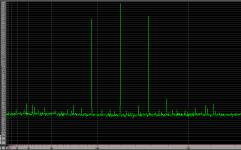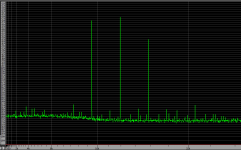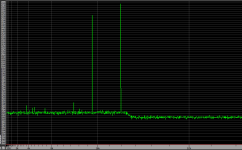Thanks a lot. Curious to listen to it (waiting download to end).I rather enjoy sometimes listening to recordings on a single string piano. David Klavins in Hungary makes them [
if we scaled back to 2k maybe...
Try it, or just listen to PMA's file, see if you can hear 200Hz
Last edited:
JN:
Maybe think about it this way. You have two signals, 5KHz and 20KHz adding linearly. They are passed through a 22050Hz LPF. They both pass unchanged; there is no nonlinear mechanism to cause any new frequencies. Now they are sampled (together) which is a multiplicative process, causing lots of new frequencies, all above 22050Hz.
Let's ignore quantization, dither and D/A because they're irrelevant here.
Finally, the sampled stream goes through another 22050Hz LPF. The output of this LPF has 5KHz and 20KHz components, and nothing else. Whatever "beats" or other relationships the original signal had is intact, minus the effects of the LPFs.
The internal sampling part of this process is (ideally, of course) perfectly transparent. The only effects that the process has on the signal(s) passing through it are from the LPFs.
That you don't appear to believe that, is why I call your quest an exercise in Nyquist denial.
Always the best fortune,
Chris
Maybe think about it this way. You have two signals, 5KHz and 20KHz adding linearly. They are passed through a 22050Hz LPF. They both pass unchanged; there is no nonlinear mechanism to cause any new frequencies. Now they are sampled (together) which is a multiplicative process, causing lots of new frequencies, all above 22050Hz.
Let's ignore quantization, dither and D/A because they're irrelevant here.
Finally, the sampled stream goes through another 22050Hz LPF. The output of this LPF has 5KHz and 20KHz components, and nothing else. Whatever "beats" or other relationships the original signal had is intact, minus the effects of the LPFs.
The internal sampling part of this process is (ideally, of course) perfectly transparent. The only effects that the process has on the signal(s) passing through it are from the LPFs.
That you don't appear to believe that, is why I call your quest an exercise in Nyquist denial.
Always the best fortune,
Chris
Last edited:
Well, first, I cannot hear 20K.😉
if we scaled back to 2k maybe...
If you look at the summation waveform, it does have 20k. But every modulation lobe has opposite polarity.
The really interesting thing is, if I brickwall the composite grey waveform, the output will be 17.5Khz. With sufficient taps, it will be steady state as well.
jn
Might be interesting to to try 2 khz with a 4.41khz sample rate, and listen for a difference.
I rather enjoy sometimes listening to recordings on a single string piano. David Klavins in Hungary makes them.
Heres some other interesting instruments: YouTube
I have to point out that mathematically synthesized signals at 44.1kHz sampling include the aliases (you essentially make an A/D with no anti-aliasing filter). The only way to do test exercises is to do them at a higher sampling rate and down sampling the result. Sampling a 20kHz sine gives exactly the same picture as a 24.1kHz one does and after reconstruction gives a 20kHz sine wave, obviously a wrong answer.
Why bring that into the conversation?
Which conversation you have in mind?
I have to point out that mathematically synthesized signals at 44.1kHz sampling include the aliases (you essentially make an A/D with no anti-aliasing filter). The only way to do test exercises is to do them at a higher sampling rate and down sampling the result. Sampling a 20kHz sine gives exactly the same picture as a 24.1kHz one does and after reconstruction gives a 20kHz sine wave, obviously a wrong answer.
OOops. can you elaborate on the last sentence.
THx-RNMarsh
I am reminded of a miniature poodle barking incessantly at the lions at the zoo, yapping from the non dangerous side of the cage.
jn
more like the guy with the whip and chair trying to keep focused the lions all around you wanting to make a meal of you just for fun. I swear ADD is alive and well here.... which makes it more dangerous. 🙂
-Richard
Tungna is an interesting musical instrument. If you like something different. Or the Sarangi (Nepal violin) YouTube
I will be returning to Nepal to see the house I gave money to build it turned out and sleep there for awhile. Lots of music and dancing all the time in Nepal. Being built to withstand an 8.0. And, to see my other student who just got her civil engineering degree and contractors license yesterday. The second student is still in Sydney university - will be an EE and run you guys into the ground. hahaha. Also a girl from poor family in Nepal. Both amazing talents.
Lots to do... check in and see your progress of the lions ... at this zoo. Later.
Last edited:
I am reminded of a miniature poodle barking incessantly at the lions at the zoo, yapping from the non dangerous side of the cage.
You mean you are the lion, right? Arf! (™ T-E)

I rather enjoy sometimes listening to recordings on a single string piano. David Klavins in Hungary makes them Una Corda - Klavins Piano and they are used to good effect by Nils Frahm, if you like his sort of music...
I thought you meant one string. IIRC Pauline Oliveros did some work with one LONG piano wire strung across a barn.
The correct test in that case is to take a high rate file and compare it to that same file dropped to 44.1.
If a listening test, not so fast. There are many other uncontrolled factors that could potentially mask or confound determination of what might otherwise may or may not be audible.
Last edited:
The 2000 marble one after is cool too.
Some people have way too much time, wonder how many man hours that took.
I thought you meant one string. IIRC Pauline Oliveros did some work with one LONG piano wire strung across a barn.
Ah no sorry, I should have added 'per note'
Nobody is talking about adding 20 k and 5 k.
I chose those because you were using them, but pick any numbers you want. Anything that can fit under the LPFs can be reproduced (ideally) perfectly. Only the filters are interesting.
Always the best,
Chris
The sum of the two frequencies show a 20Khz signal...
Not exactly. There is not 20kHz in the sense of Fourier. There is a sort-of 20kHz-looking signal in your opinion since it kind of appears that way to your eye (your brain, actually). Ever seen face in cloud or in something else that isn't really a face? Of course, you know it would be naive to believe you saw an actual face in that case, someone else might not be so wise in every situation.
OK, it turns out I have an older audio editing software on one of our machines that allows me to modulate one audio file by another.
I generated dithered 5kHz and 20kHz -10dBFS test tones and then created 20kHz modulated by 5kHz test file. Exactly as what Jn was talking about. All this at 88.2kHz 24bits (HiRez).
Spectrum of that signal is below (64k FFT). As expected, one can see 20kHz tone and sidebands at 15kHz and 25kHz.
(Ignore the "grass" at around -145dB, it is probably truncation distortion due to plain 32bit float operation and no dithering to 24bits at the output of that particular software).
Then I loaded the test file in another editor and applied two LP filters in a row at 22.050kHz with Q=0.7 and slope of 48dB/oct.
As one can see, only amplitude of sidebands have changed - there are no new tones there 😉
Then, in a way to apply the "brutal" brickwall filter, I took the same test file and downsampled it to 44.1kHz. Then I upsampled it back to 88.2kHz so that it could be better observed on analyzer.
The upper sideband at 25kHz is gone, but, again, I see no new tones and no frequency shift.
Test files (20 second snippets) are here for about five days:
WeTransfer
Analyze away!
I generated dithered 5kHz and 20kHz -10dBFS test tones and then created 20kHz modulated by 5kHz test file. Exactly as what Jn was talking about. All this at 88.2kHz 24bits (HiRez).
Spectrum of that signal is below (64k FFT). As expected, one can see 20kHz tone and sidebands at 15kHz and 25kHz.
(Ignore the "grass" at around -145dB, it is probably truncation distortion due to plain 32bit float operation and no dithering to 24bits at the output of that particular software).
Then I loaded the test file in another editor and applied two LP filters in a row at 22.050kHz with Q=0.7 and slope of 48dB/oct.
As one can see, only amplitude of sidebands have changed - there are no new tones there 😉
Then, in a way to apply the "brutal" brickwall filter, I took the same test file and downsampled it to 44.1kHz. Then I upsampled it back to 88.2kHz so that it could be better observed on analyzer.
The upper sideband at 25kHz is gone, but, again, I see no new tones and no frequency shift.
Test files (20 second snippets) are here for about five days:
WeTransfer
Analyze away!
Attachments
Last edited:
- Status
- Not open for further replies.
- Home
- Member Areas
- The Lounge
- John Curl's Blowtorch preamplifier part III


